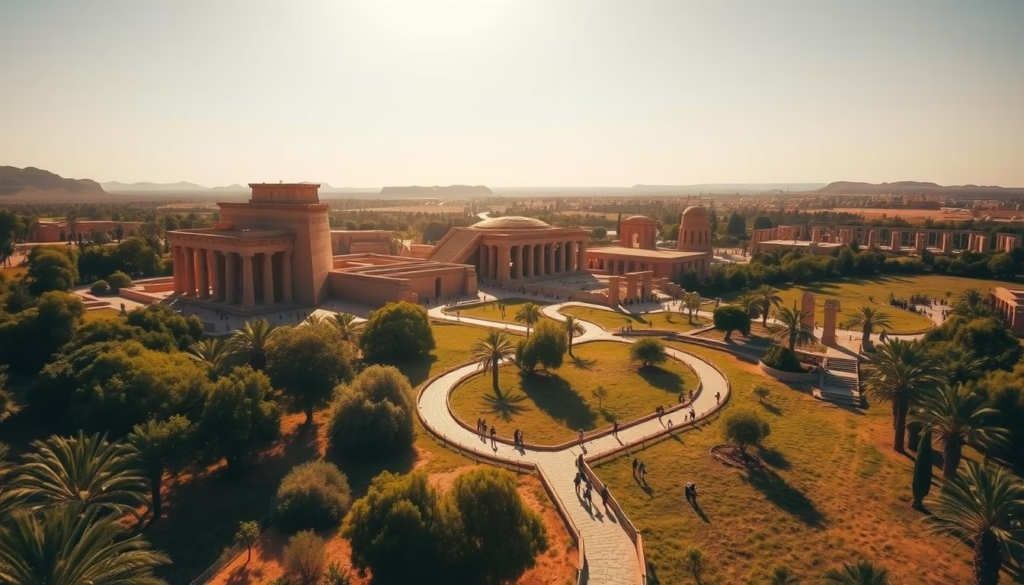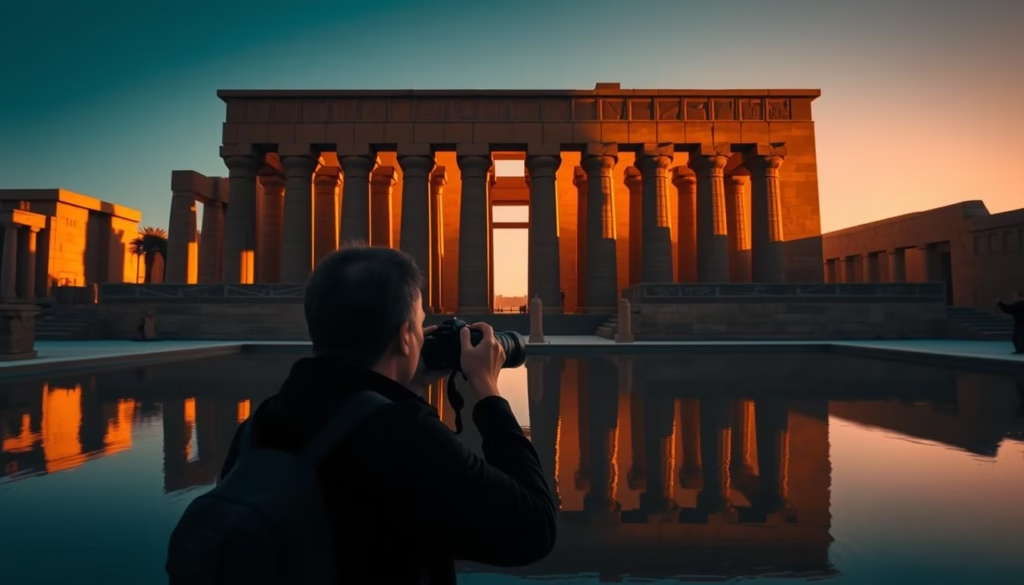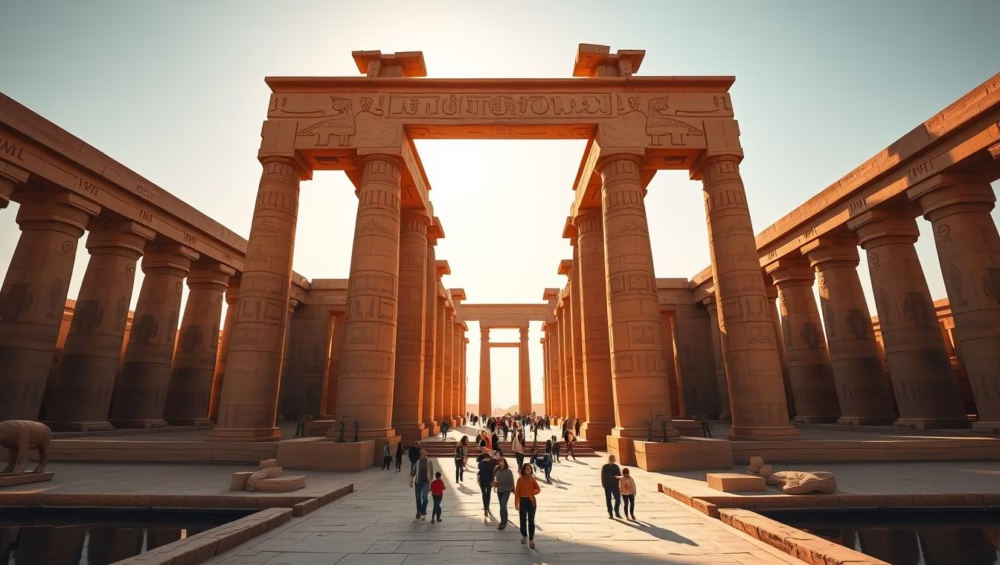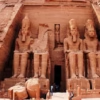The Karnak Temple: Discovering 5 Fascinating Secrets
The Karnak Temple is a UNESCO World Heritage Site and an impressive monument of ancient Egypt. For centuries, it has attracted visitors from around the world. This temple is a breathtaking experience.
The Karnak Temple in Egypt is a must-visit for history and architecture enthusiasts. As a UNESCO World Heritage Site, it showcases Egypt’s rich history and culture.
The Karnak Temple: An Overview of Ancient Egypt’s Largest Sanctuary
The Karnak Temple is located near Luxor. It is a remarkable testament to the history of ancient Egypt. The temple complex in Luxor is renowned for its size and significance during the pharaonic era.
The name “Karnak” derives from the Arabic term for the temple. The temple was a significant site for the pharaohs and played a central role in ancient Egyptian history.

The Meaning of the Name “Karnak”
The name “Karnak” is closely tied to the temple’s history. The temple complex in Luxor was an important site for the pharaohs, and the name reflects this significance.
Geographic Location and Surroundings
The Karnak Temple is situated near Luxor. It is surrounded by a landscape that mirrors the history of ancient Egypt. The temple complex in Luxor is neighbored by other historical sites documenting the pharaonic era.
Historical Significance in Ancient Egypt
The Karnak Temple played a central role in ancient Egyptian history. The pharaonic era was marked by the temple’s importance, as it served as a key site for the pharaohs.
Architectural Evolution Over Three Millennia
The Karnak Temple in Egypt demonstrates the impressive architecture of ancient Egypt. Constructed and expanded over three millennia, it reflects architectural developments across different eras.
The temple’s architecture showcases various epochs and styles, from the early pharaohs to the Roman period. Continuous modifications and expansions explain its unique design.
Key features of its development include:
- Use of columns and pillars.
- Construction of halls and chambers.
- Decorative hieroglyphs and reliefs.
- Integration of sacred lakes and processional pathways.
The archaeology of the Karnak Temple provides insights into Egypt’s history and culture. The temple stands as evidence of architectural evolution and is a vital part of Egyptian temple architecture.

The Great Hypostyle Hall: The Heart of the Karnak Temple
The Great Hypostyle Hall is an awe-inspiring section of the Karnak Temple. It was a major site for religious ceremonies, drawing countless visitors from around the world.
The hall’s architecture is breathtaking, dominated by 134 monumental columns. These columns are not only architecturally significant but also deeply tied to religious traditions.
The 134 Monumental Columns
The sandstone columns reach heights of up to 13 meters and are adorned with hieroglyphs and carvings depicting stories from ancient Egyptian history and mythology.
Light and Shadow Play
The Hypostyle Hall is famed for its striking interplay of light and shadow, created by the columns and sunlight. These effects are most dramatic in the early morning and late afternoon.
The Karnak Temple is a popular destination for travelers seeking history, architecture, and sacred sites. The Great Hypostyle Hall is a primary reason for the temple’s exceptional appeal.
The Sacred Lakes and Processional Pathways
At the heart of the Karnak Temple lie the sacred lakes and processional pathways. These elements were integral to the temple complex, serving ritual purposes and contributing to its UNESCO World Heritage status.
The sacred lakes were used for purification rites and other religious ceremonies. The processional pathways were reserved for pharaohs and dignitaries approaching the temple, offering a glimpse into Egypt’s rich history and culture.
The combination of sacred lakes and processional pathways makes the Karnak Temple unique. Visitors can stroll along these paths and explore the lakes, gaining insight into Egypt’s heritage. The temple is a must-see for anyone interested in Egypt’s history and culture, forming a key part of its UNESCO World Heritage.
Hieroglyphs and Wall Reliefs: History Carved in Stone
The hieroglyphs and wall reliefs of the Karnak Temple are a vital part of Egypt’s history. They narrate tales from the pharaonic era, providing insight into religious and historical events.
The most significant inscriptions and depictions adorn the temple walls and columns, helping scholars understand Egypt’s past and the pharaonic period.
Key aspects of these carvings include:
- Depictions of gods and goddesses.
- Accounts of historical events.
- Use of symbols and hieroglyphs.
The hieroglyphs and reliefs at Karnak are unparalleled, showcasing ancient Egyptian culture and religion. They form an essential part of humanity’s cultural heritage.
The Temple’s Role in Religious Life
The Karnak Temple was central to ancient Egyptian religious practices, serving as a place of worship and ritual ceremonies.
Today, the temple attracts visitors worldwide who come to learn about Egypt’s history. It reveals how ancient Egyptians lived and worshipped.
The temple houses numerous sacred sites, offering spiritual significance and helping visitors understand its importance.
The Karnak Temple is not only of interest to historians but also to those drawn to ancient Egyptian spirituality.
Restoration and Preservation Efforts
The Karnak Temple is a priceless cultural treasure, requiring ongoing preservation and restoration. Archaeology plays a key role in protecting such temples.
Numerous projects focus on conserving the temple, including restoring columns, walls, hieroglyphs, and reliefs.
Current Projects
- Restoration of columns and walls.
- Conservation of hieroglyphs and reliefs.
- Preservation of archaeological finds.
Conservation Challenges
Preserving the Karnak Temple is a complex task, requiring a balance between maintaining its original beauty and mitigating environmental factors like heat and humidity.
Visitor Information and Practical Tips
The Karnak Temple is a popular destination in Egypt, drawing millions annually. Here are some tips to enhance your visit.
Opening Hours and Ticket Prices
The temple is open daily from 6 AM to 5 PM. Ticket prices vary by season; advance booking is recommended to avoid long queues.
Best Times to Visit
Early mornings or late afternoons are ideal to avoid the midday heat and crowds.
Guided Tours
A local guide is highly recommended to fully appreciate the temple’s highlights and history.
The Sound and Light Show in the Evening
A highlight of visiting the Karnak Temple is the spectacular Sound and Light Show in the evening. This immersive experience delves into the temple’s history and significance, creating an unforgettable memory.
The show combines light, sound, and the temple’s structures to produce a mesmerizing atmosphere. It is a perfect way to conclude a day of exploration.
Photography at the Karnak Temple: Tips and Regulations
The Karnak Temple is a photographer’s dream, offering stunning architectural and historical subjects. Before shooting, familiarize yourself with the site’s photography rules to respect sacred areas and other visitors.
Best Photo Spots
- The Great Hypostyle Hall.
- The Sacred Lakes.
- The Processional Pathways.
Technical Recommendations
Use a high-quality camera with a wide-angle lens. Early morning or late afternoon light provides the best conditions.
Connection to Other Historical Sites in Luxor
The Karnak Temple is one of many historical sites in Luxor, a city rich in ancient Egyptian heritage. Key nearby sites include:
- The Luxor Temple.
- The Valley of the Kings.
- The Valley of the Queens.
Exploring these sites offers a comprehensive understanding of the pharaonic era.

Local Legends and Mythology
The Karnak Temple is steeped in legends and mythology, reflecting the beliefs of ancient Egyptians. Its divine stories and folk traditions provide a fascinating glimpse into the past.
Modern Research and Archaeological Discoveries
Archaeological research at Karnak continues to uncover new insights into ancient Egyptian civilization. Modern techniques help decode the temple’s construction, symbolism, and societal role.
How to Plan Your Visit
To make the most of your trip to Egypt, plan your Karnak Temple visit carefully:
Recommended Routes
- Start early to avoid crowds.
- Follow a logical route to appreciate the temple’s layout and history.
Time Management
Allocate sufficient time to explore each section thoroughly.
Conclusion: A Timeless Monument of Egyptian Civilization
The Karnak Temple is a jewel of ancient architecture, symbolizing Egypt’s grandeur. As a UNESCO World Heritage Site, it embodies the nation’s history and spiritual traditions.
Its majestic halls and intricate reliefs offer a window into pharaonic civilization, leaving visitors captivated by its mystique.
FAQ
What is the Karnak Temple?
The Karnak Temple is an ancient Egyptian monument and UNESCO World Heritage Site near Luxor, serving as a key site for pharaohs.
Where is the Karnak Temple located?
It is situated in Luxor, on the east bank of the Nile.
When was the Karnak Temple built?
Construction spanned over 2,000 years, beginning in the 11th Dynasty and continuing into the Roman era.
What are its architectural highlights?
The Great Hypostyle Hall, sacred lakes, processional pathways, and hieroglyphic inscriptions.
What was its religious significance?
It was a central site for worship and ceremonies in ancient Egypt.
How should I plan my visit?
Visit early or late in the day, consider a guided tour, and allocate ample time.
What are the best photo opportunities?
The Hypostyle Hall, sacred lakes, and processional pathways.
How is it connected to other Luxor sites?
It is part of a larger historical ensemble, including the Luxor Temple and the Valleys of the Kings and Queens.





